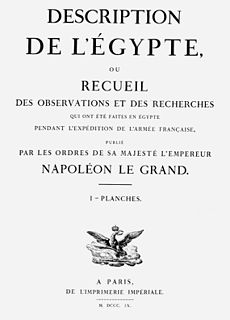 W
WThe Description de l'Égypte was a series of publications, appearing first in 1809 and continuing until the final volume appeared in 1829, which aimed to comprehensively catalog all known aspects of ancient and modern Egypt as well as its natural history. It is the collaborative work of about 160 civilian scholars and scientists, known popularly as the savants, who accompanied Bonaparte's expedition to Egypt in 1798 to 1801 as part of the French Revolutionary Wars, as well as about 2000 artists and technicians, including 400 engravers, who would later compile it into a full work.
 W
WEssai sur les hiéroglyphes des Égyptiens was a significant 1744 French translation of an English work on the history of writing.
 W
WGrammaire égyptienne is a grammar reference book by the French Egyptologist Jean-François Champollion, published posthumously in France in 1836. Its full title, the Grammaire égyptienne ou Principes généraux de l'écriture sacrée égyptienne appliqué à la présentation de la langue parlée means Egyptian Grammar or General Principles of Egyptian Sacred Writing Applied to the Presentation of the Spoken Language.
 W
WLingua Aegyptiaca Restituta was a 1643 work about the Coptic language by the Jesuit scholar Athanasius Kircher. It followed his 1636 volume Prodromus Coptus sive Aegyptiacus, the first ever published grammar of Coptic. Lingua Aegyptiaca Restituta was dedicated to the Holy Roman Emperor Ferdinand III and published in Rome by Herman Scheuss.
 W
WThe Message of the Sphinx: A Quest for the Hidden Legacy of Mankind is a pseudoarchaeology book written by Graham Hancock and Robert Bauval in 1996 which argues that the creation of the Sphinx and Pyramids occurred as far back as 10,500 BC using astronomical data.
 W
WObeliscus Pamphilius is a 1650 work by the Jesuit scholar Athanasius Kircher. It was published in Rome by Ludovico Grignani and dedicated to Pope Innocent X in his jubilee year. The subject of the work was Kircher's attempt to translate the hieroglyphs on the sides of an obelisk erected in the Piazza Navona.
 W
WOedipus Aegyptiacus is Athanasius Kircher's supreme work of Egyptology.
 W
WProdromus Coptus sive Aegyptiacus was a 1636 work by the Jesuit scholar Athanasius Kircher. It was published in Rome by the Sacred Congregation for the Propagation of the Faith and dedicated to the Prefect of the Congregation, Cardinal Francesco Barberini. The book was Kircher's first venture into the field of Egyptology, and it also contained the first ever published grammar of the Coptic language.
 W
WThe Search for Ancient Egypt is an illustrated monograph on the history of the rediscovery of ancient Egypt and of Egyptology, in pocket format. Written by the French Egyptologist Jean Vercoutter, this work is the first volume in the “Découvertes Gallimard” collection. It was awarded a literary prize by the Fondation de France in 1987.
 W
WUrkunden des ægyptischen Altertums is a series of editions of Ancient Egyptian texts, published between 1903–1961.
 W
WUrkunden des ægyptischen Altertums is a series of editions of Ancient Egyptian texts, published between 1903–1961.
 W
WVoyage d'Egypte et de Nubie (1755) records Frederic Louis Norden's extensive documentation and drawings of his voyage through Egypt in 1737–38. It contains some of the very first realistic drawings of Egyptian monuments and to this day remains a primary source for the looks of Egyptian monuments before widespread 19th and 20th-century tourism and excavations.